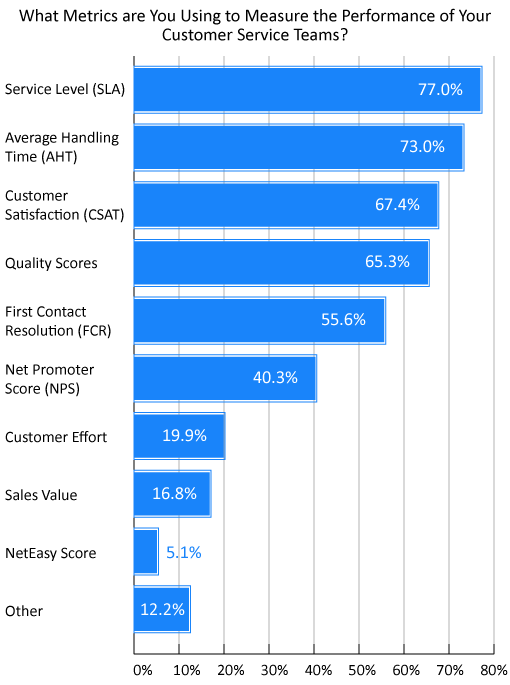We introduce four key customer service objectives that will improve both contact centre productivity and customer experience.
Objective No 1. Choose the Right Measurements
It’s a senior management responsibility to choose the right measurements and metrics for advisors, based on both a new definition of advisor productivity and wider organizational goals.
To improve advisor productivity, we first need to define it. We need to understand what advisors individually bring to productivity, which – according to Daniel Ord, Founder of OmniTouch International, includes:
- Adhering to schedule – aka being in the right place at the right time
- Applying what they’ve been taught and inspired to do so through their knowledge, skills and abilities – which in turn impacts quality
- Exhibiting flexibility to learn interaction skills across multiple channels of customer contact – for example, the ability to handle live chats, phone calls and emails
We must think about each of these things when deciding how we will measure the performance of our agents and, by extension, the customer service teams.

By applying this objective we will avoid sending mixed messages to advisors in terms of rushing through calls but also expecting them to provide good customer service. Instead everyone will know what is expected of them and how they can best support customers.
Just remember Daniel’s key point: “Quantity cultures don’t equal productivity cultures. It’s time for us to uncouple this belief.”
Objective No 2. Design First Contact Resolution
While it’s important to assess advisor performance, we also have to look at the demand side and why customers are contacting us, if we want to boost productivity and improve customer experience further.
First Contact Resolution (FCR) is a good metric to help us understand our demand, but it is easy to use this metric in the wrong way.
While the customer may have a problem now, what they don’t know is what issues may crop up down the road. Maybe not the same issue, but something related to that original issue.
If we look at traditional FCR, it’s going to be treated as a new issue, because when the customer posed query X to us, we handled query X. When they asked us a second query (Y), we handled query Y.
That means we have achieved two good FCR scores. But that’s not how customers think about it. To them, queries X and Y are related and they’re going to tell people that you’re hard to do business with. They’ll blame you for not preparing them with the things they needed to know.
“While FCR is a step in the right direction, we need to be thinking not just in terms of eliminating unnecessary repeat contacts, but let’s really take a look at the elimination of unnecessary additional contacts,” adds Daniel.
While your FCR rates may not look as wonderful as they did before, you are going to find out what is causing repeat contacts and therefore improve productivity by lowering demand, all while making the experience more satisfying for customers.
Objective 3. Get Smarter About Channel Optimization
Contact centres often look to shift customers from one channel to another to modify contact centre demand.
However, this strategy only works well if we think in terms of matching the query to the channel that’s best suited to handle that query type.
For example, it’s unlikely that anyone really wants to resolve a technical support query over email. So don’t force these queries down this channel.
“There’s a belief out there that if we simply offer a lot of channels, that will automatically make customers more satisfied. But that’s not necessarily true,” says Daniel.
“This is because when they have a problem or a question, the customer has to think: which channel do I have to go to get this thing resolved as easily as possible?”
Having this conundrum, customers will normally default to using the phone for most contact reasons.
To prevent this, we can evaluate which channels are best suited to which queries in terms of customer satisfaction (CSAT), FCR and average handling time (AHT). We can apply these diagnostics to better direct customers with improved website navigation.
For more in the topic of channel shift, listen to the following episode of The Contact Centre Podcast, which features a conversation with Dr Nicola Millard, a contact centre expert.
The Contact Centre Podcast – Episode 6:
Channel Shift: How Can We Safely Move Customers From One Channel To Another?
For more information on this podcast visit Podcast: Channel Shift: How can we safely move customers from one channel to another?
Objective 4. Give Advisors the Right Tools
The financial cost of running a contact centre is very much linked to handling times and how much demand is coming in. While this fact often leads to bad practices – like targeting advisors on AHT – it’s something that we cannot get away from.
To reduce this demand and lower handle times in a way that will not negatively impact customer experience, it is best practice to lean on technology.
While we can do other things to reduce handling time, like teach abbreviations to reduce wrap-time and improve coaching for calls with high transfer rates, the best thing that we can do is make the advisor experience as simple as possible. This involves giving them the right tools.
“I’m fascinated by the bots and automation tools that we’re giving to agents and how we implement them to enable agents to deliver a better customer experience,” adds Daniel.
To really improve the advisor experience and better support our customer service team in lowering AHT and reducing demand, here are some technologies that we may want to consider implementing:
- Noise-cancelling wireless headsets to help advisors better concentrate on the matter at hand and remove that feeling of being “tethered” to a desk all day
- Screen-pops that help to serve up lots of useful customer information as soon as that customer’s contact comes through
- A knowledge base that’s well managed, so it only includes high-quality, up-to-date insights
- Automation that automatically fills in after-call-work for the advisor, as they are interacting with customers
- Visual flows that provide real-time guidance to advisors and are much less rigid and better to look at than traditional call scripts
Learn more about providing advisors with the best possible software in our article: Give Agents the Right Tools to Do Their Job
The Wrong Customer Service Objectives to Improve Productivity
A key point that we’ve highlighted in these objectives is that we need to correctly define contact centre productivity.
Many contact centres consider productivity to be answering as many calls as possible in as short a time as possible.
So they actively target advisors on metrics like SLA and AHT.
In fact, these two metrics are the most commonly used to measure the performance of customer service teams, according to our new research.

But this is not good practice and these results are worrying.
Why? Well, service level (SLA) is something that advisors have no individual control over. It’s a metric for the workforce management (WFM) team only. The same logic applies to occupancy.
Whereas if we target the team on AHT, we encourage advisors to rush through calls, leading to lower First Call Resolution rates – meaning that we will likely have the opposite impact on call centre productivity than intended. This is all while stressing out advisors.
Changing Your Productivity Definition
The key thing to remember here is that targeting contact centre productivity as a customer service objective is not a bad thing, we just need to redefine what we mean by productivity.
In a contact centre context, we cannot think of productivity as how fast and how many. A contact centre is not a factory.
The following video reflects an interesting view of why this can be a problem.
This video was recommended to us by Daniel, who says: “Imagine that every piece of chocolate that you see in this video represents a customer. If you’re running your contact centre like an industrial factory, that’s what your customers are going through.”
Instead, we need to realize that different stakeholders have different contributions to productivity; it is not solely the responsibility of the customer service team.
Once we understand this, we can apply the customer service objectives above that will increase contact centre productivity in the right way, while also improving customer experience.
For more on the topic of measuring productivity in the right way, read our article: How to Calculate Productivity in the Contact Centre
Other People and Departments Are Responsible for Productivity Too
One key point that we’ve made in this article is that different stakeholders have different contributions to productivity. It is not only the contact centre that should be setting objectives to boost productivity.
For example, we can also think about the impact of customer experience management.
Not every organization will have a formalized customer experience management function, but nevertheless we need to recognize that it is not the same as contact centre management.
Customer experience experts have a different area of expertise and they can really help to improve customer service functions and productivity across the organization, as Daniel discusses in the video below.
Customer experience management can be a blessing for many contact centre managers, as they won’t have the authority to demand changes in another department to improve productivity – but a customer experience manager can help enforce that change.
Having this strong focus on what’s best for the customer will hopefully help to remove customer demand, as, after all, the best service is no service.
To get a better understanding of this topic, read our article: What Is Customer Experience Management?
Final Thoughts
“When we manage which contacts come in, get them to where they’re best handled and design how we should handle them, then productivity becomes an outcome – not the overarching target,” says Daniel.
So, if we combine each of the four customer service objectives above, we end up achieving productivity, but it’s not a “let’s handle as many calls as possible” definition of productivity. We instead improve productivity in a customer-experience-friendly way.
By doing this, we not only optimize costs in the long run, but, as Daniel concludes: “We turn advisors into powerhouses of engagement and loyalty.”
Find out our top ten contact centre objectives by reading our article: The Contact Centre Manifesto – Don’t Do ANYTHING Until You Have Done These 10 Things!
For more advice on setting new standards for customer service, read our articles:
- 10 Employee Focused Customer Service Goals
- 10 Examples of Exceptional Customer Service
- 20 Contact Centre Objectives
Author: Robyn Coppell
Reviewed by: Hannah Swankie
Published On: 24th Jun 2020 - Last modified: 23rd Sep 2025
Read more about - Customer Service Strategy, Customer Service, Daniel Ord, Editor's Picks, Handling Customers, Metrics, Nicola Millard, Productivity, Service Strategy









































